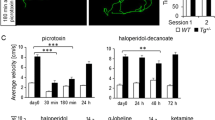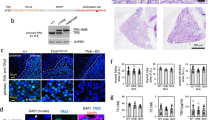Abstract
Two thyroid hormone response elements (TREs), designated A1 TRE (−295/−268) and B1 TRE (+207/+227), have been identified within the Purkinje cell-expressed Pcp-2 gene. Previous studies have characterized the A1 TRE (Zou et al., 1994). This article analyzes the structural and functional characteristics of the intronic B1 TRE. The B1 sequence contains four overlapping TRE half-sites. The 3′ DR4 motif, consisting of the second and forth half-sites, is responsible for the T3 induction observed with the B1 sequence. Gel-shift analysis reveals developmentally regulated complexes that are abundant in the fetus and at birth and then fall precipitously in the neonate bind to B1. The observed time-course of these complexes varies inversely with the rise in Pcp-2 expression, thus raising the possibility that the complexes may represent inhibitory factors. Supershift analysis indicates that endogenous TRα1 is present in the fetal nuclear protein complexes that bind to B1. Competition analysis also indicates the second B1 TRE half-site is important in binding the TRα1-TRAP complexes. These studies suggest that the B1 sequence may bind potential TRα1-TRAP repressor complexes in the fetus, whereas in the neonate, these TRE sites may be involved in the activation of Pcp-2 by binding other TR-TRAP-activating complexes.
Similar content being viewed by others
Abbreviations
- T3:
-
3,5,3′-l-triiodothyronine (thyroid hormone)
- TR(s):
-
thyroid hormone receptor(s)
- TRE(s):
-
thyroid hormone response element(s)
- RXR:
-
9-cis retinoic acid receptor
- Pcp-2:
-
Purkinje cell protein-2
- DR4:
-
direct repeat 4
- TRAP(s):
-
thyroid hormone receptor auxiliary protein(s)
References
Baniahmad A., Tsai S. Y., O’Malley B. W., and Tsai M.-J. (1992) Kindred S thyroid hormone receptor is an active and constitutive silencer and a repressor for thyroid and retinoic responses.Proc. Natl. Acad. Sci. USA 89, 10,633–10,637.
Baniahmad A., Ha I., Reinberg D., Tsai S. Y., Tsai M.-J., and O’Malley B. W. (1993) Interaction of human thyroid hormone receptor β with transcription factor TFIIB may mediate target gene derepression and activation by thyroid hormone.Proc. Natl. Acad. Sci. USA 90, 8832–8836.
Baniahmad A., Leng X., Burris T. P., Tsai S. Y., Tsai M.-J., and O’Malley B. W. (1995) The tau 4 activation domain of the thyroid hormone receptor is required for release of a putative corepressor(s) necessary for transcriptional silencing.Mol. Cell. Biol. 15, 76–86.
Beebe J. S., Darling D. S., and Chin W. W. (1991) 3,5,3′-triiodothyronine receptor auxiliary protein (TRAP) enhances receptor binding by interactions within the thyroid hormone response element.Mol. Endocrinol. 5, 85–93.
Berrodin T. J., Marks M. S., Ozato K., Linney E., and Lazar M. A. (1992) Heterodimerization among thyroid hormone receptor, retinoic acid receptor, retinoid X receptor, chicken ovalbumin upstream promoter transcription factor, and an endogenous liver protein.Mol. Endocrinol. 6, 1468–1478.
Bradford M. M. (1976) A rapid and sensitive method for the quantitation of microgram quantities of protein utilizing the principle of protein-dye binding.Anal. Biochem. 72, 248–254.
Bradley D. J., Towle H. C., and Young W. S. (1992) Spatial and temporal expression of α- and β-thyroid hormone receptor mRNAs, including the β2 subtype, in the developing mammalian nervous system.J. Neurosci. 12, 2288–2302.
Brent G., Dunn M., Harney J., Gulick T., Larsen P. R., and Moore D. (1989) Thyroid hormone aporeceptor represses T3-inducible promoters and blocks activation of the retinoic acid receptor.New Biol. 1, 329–336.
Brent G. A., Moore D. D., and Larsen P. R. (1991a) Thyroid hormone regulation of gene expression.Annu. Rev. Physiol. 53, 17–35.
Brent G. A., Williams G. R., Harney J. W., Forman B. M., Samuels H. H., Moore D. D., and Larsen P. R. (1991b) Effects of varying the position of thyroid hormone response elements within the rat growth hormone promoter: implications for positive and negative regulation by 3,5,3′-triiodothyronine.Mol. Endocrinol. 5, 542–548.
Burnside J., Darling D. S., and Chin W. W. (1990) A nuclear factor that enhances binding of thyroid hormone receptors to thyroid hormone response elements.J. Biol. Chem. 265, 2500–2504.
Carlson D., Strait K., Schwartz H., and Oppenheimer J. (1994) Immunofluorescent localization of thyroid hormone receptor isoforms in glial cells of rat brain.Endocrinology 135, 1831–1836.
Damm K., Thompson C. C., and Evans R. M. (1989) Protein encoded by v-erb A functions as a thyroid-hormone receptor antagonist.Nature 340, 242–244.
Darling D. S., Beebe J. S., Burnside J., Winslow E. R., and Chin W. W. (1991) 3,5,3′-triiodothyronine (T3) receptor-auxiliary protein (TRAP) binds DNA and forms heterodimers with the T3 receptor.Mol. Endocrinol. 5, 73–84.
Dignam J. D. (1990) Preparation of extracts from higher eukaryotes, inMethods in Enzymology (Deutscher M. P., ed.), Academic, San Diego, pp. 194–203.
Farsetti A., Robbins J., and Nikodem V. (1990) Molecular basis of thyroid hormone regulation of myelin basic protein gene expression in rodent brain.J. Biol. Chem. 266, 23,226–23,232.
Fondell J. D., Roy A. L., and Roeder R. G. (1993) Unliganded thyroid hormone receptor inhibits formation of a functional preinitiation complex: implications for active repression.Genes Dev. 7, 1400–1410.
Forrest D., Hallböök F., Persson H., and Vennström B. (1991) Distinct functions for thyroid hormone receptors α and β in brain development indicated by differential expression of receptor genes.EMBO J. 10, 269–275.
Glass C. K., Franco R., Weinberger A. V. R., Evans R. M., and Rosenfeld M. G. (1987) A c-erbA binding site in rat growth hormone gene mediates trans-activation by thyroid hormone.Nature 329, 738–741.
Hall B. L., Smit-McBride Z., and Privalsky M. L. (1993) Reconstitution of retinoid X receptor function and combinatorial regulation of other nuclear hormone receptors in the yeastSaccharomyces cerevisiae.Proc. Natl. Acad. Sci. USA 90, 6929–6933.
Koenig R. J., Brent G. A., Warne R. L., Larsen P. R., and Moore D. D. (1987) Thyroid hormone receptor binds to a site in the rat growth hormone promoter required for induction by thyroid hormone.Proc. Natl. Acad. Sci. USA 84, 5670–5674.
Lazar M. A., Berrodin T. J., and Harding H. P. (1991) Differential DNA binding by monomeric, homodimeric, and potentially heterodimeric forms of the thyroid hormone receptor.Mol. Cell. Biol. 11, 5005–5015.
Lee I. J., Driggers P. H., Medin J. A., Nikodem V. M., and Ozato K. (1994) Recombinant thyroid hormone receptor and retinoid X receptor stimulate ligand-dependent transcription in vitro.Proc. Natl. Acad. Sci. USA 91, 1647–1651.
Legrand J. (1967) Analyse de l’action morphogenetique des hormones thyroidiennes sur le cervelet du jeune rat.Arch. Anat. Microscop. Morphol. Exp. 56, 205–244.
Legrand J. (1986) Thyroid hormone effects on growth and development, inThyroid Hormone Metabolism (Hennemann G., ed.), Marcel Dekker, New York, pp, 503–534.
Miyamoto T., Suzuki S., and DeGroot L. J. (1994) Differential binding and activation of thyroid hormone response elements by TR alpha 1 and RXR alpha-trap heterodimers.Mol. Cell. Endocrinol. 102, 111–117.
Murray M. B. and Towle H. C. (1989) Identification of nuclear factors that enhance binding of the thyroid hormone receptor to a thyroid hormone response element.Mol. Endocrinol. 3, 1434–1442.
Nordeen S. K. (1988) Luciferase reporter gene vectors for analysis of promoters and enhancers.Biotechniques 6, 454–467.
Nordquist D. T., Kozak C. A., and Orr H. T. (1988) cDNA cloning and characterization of three genes uniquely expressed in cerebellum by Purkinje cells.J. Neurosci. 8, 223–226.
Norman M. F., Lavin T. N., Baxter J. D., and West B. L. (1989) The rat growth hormone gene contains multiple thyroid response elements.J. Biol. Chem. 264, 12,063–12,073.
Oppenheimer J. H. and Samuels H. H. (1983)Molecular Basis of Thyroid Hormone Action. Academic, New York.
Rosenthal N. (1987) Identification of regulatory elements of cloned genes with functional assays, inMethods in Enzymology (Berger S. L. and Kimmel A. R., eds.), Academic, San Diego, pp. 717,718.
Ruiz de Ona C., Morreale de Escobar M., Calvo R., Escobar del Rey F., and Obregon M. J. (1991) Thyroid hormones and 5′-deiodinase in the rat fetus late in gestation: effects of maternal hypothyroidism.Endocrinology 128, 422–432.
Samuels H. H., Forman B. M., Horowitz Z. D., and Ye Z. S. (1988) Regulation of gene expression by thyroid hormone.J. Clin. Invest. 81, 957–967.
Sap J., de Magistris L., Stunnenberg H., and Vennstrom B. (1990) A major thyroid hormone response element in the third intron of the rat growth hormone gene.EMBO J. 9, 887–896.
Schwartz H. L. (1983) Effect of thyroid hormone in growth and development, inMolecular Basis of Thyroid Hormone Action (Oppenheimer J. H. and Samuels H. H., eds.), Academic, New York, pp. 413–444.
Schwartz H. L., Strait K. A., Oppenheimer J. H., and Ling N. C. (1992) Quantitation of rat tissue thyroid hormone binding receptor isoforms by immunoprecipitation of nuclear triiodothyronine binding capacity.J. Biol. Chem. 267, 11,794–11,799.
Shulemovich K., Dimaculangan D. D., Katz D., and Lazar M. A. (1995) DNA bending by thyroid hormone receptor: influence of half-site spacing and RXR.Nucleic Acids Res. 23, 811–818.
Strait K., Schwartz H., Perez-Castillo A., and Oppenheimer J. (1990) Relationship of c-erbA mRNA content to tissue triiodothyronine nuclear binding capacity and function in developing and adult rats.J. Biol. Chem. 265, 10,514–10,521.
Strait K. A., Schwartz H. L., Seybold V. S., Ling N. C., and Oppenheimer J. H. (1991) Immunofluorescent localization of thyroid hormone receptor protein β1 and variant α2 in selected tissues: cerebellar Purkinje cells as a model for β1 receptor mediated developmental effects of thyroid hormone in brain.Proc. Natl. Acad. Sci. USA 88, 3887–3891.
Strait K. A., Zou L., and Oppenheimer J. H. (1992) β1 isoform-specific regulation of a triiodothyronine-induced gene during cerebellar development.Mol. Endocrinol. 6, 1874–1880.
Sugawara A., Yen P. M., Darling D. S., and Chin W. W. (1993) Characterization and tissue expression of multiple triiodothyronine receptor-auxiliary proteins and their relationship to retinoid X receptors.Endocrinology 133, 965–971.
Thompson C. C. and Evans R. M. (1989) Trans-activation by thyroid hormone receptors. Functional parallels with steroid hormone receptors.Proc. Natl. Acad. Sci. USA 86, 3494–3498.
Thompson K. L., Santon J. B., Shephard L. B., Walton G. M., and Gill G. N. (1992) A nuclear protein is required for thyroid hormone receptor binding to an inhibitory half-site in the epidermal growth factor receptor promoter.Mol. Endocrinol. 6, 627–635.
Williams G. R. and Brent G. A. (1995) Thyroid hormone response elements, inMolecular Endocrinology: Basic Concepts and Clinical Correlations (Weintraub B. D., ed.), Raven, New York, pp. 217–239.
Yen P. M., Spanjaard R. A., Sugawara A., Darling D. S., and Nguyed V. P. (1993) Orientation and spacing of half-sites differentially affect T3-receptor (TR) monomer, homodimer, and heterodimer binding to thyroid hormone response elements (TREs).Endocrine J. 1, 461–466.
Yen P. M., Ikeda M., Brubaker J. H., Forgione M., Sugawara A., and Chin W. W. (1994) Roles of v-erbA homodimers and heterodimers in mediating dominant negative activity by v-erbA.J. Biol. Chem. 269, 903–909.
Yen P. M., Wilcox E. C., Hayashi Y., Refetoff S., and Chin W. W. (1995) Studies on the repression of basal transcription (silencing) by artificial and natural human thyroid hormone receptor-beta mutants.Endocrinology 136, 2845–2851.
Zhang X. K., Wills K. N., Graupner G., Tzukerman M., Hermann T., and Pfahl M. (1991) Ligand-binding domain of thyroid hormone receptors modulates DNA binding and determines their bifunctional roles.New Biol. 3, 169–181.
Zou L., Hagen S. G., Strait K. A., and Oppenheimer J. H. (1994) Identification of thyroid hormone response elements in rodent Pcp-2, a developmentally regulated gene of cerebellar Purkinje cells.J. Biol. Chem. 269, 13,346–13,352.
Author information
Authors and Affiliations
Rights and permissions
About this article
Cite this article
Hagen, S.G., Larson, R.J., Strait, K.A. et al. A purkinje cell protein-2 intronic thyroid hormone response element binds developmentally regulated thyroid hormone receptor-nuclear protein complexes. J Mol Neurosci 7, 245–255 (1996). https://doi.org/10.1007/BF02737062
Received:
Revised:
Accepted:
Issue Date:
DOI: https://doi.org/10.1007/BF02737062




